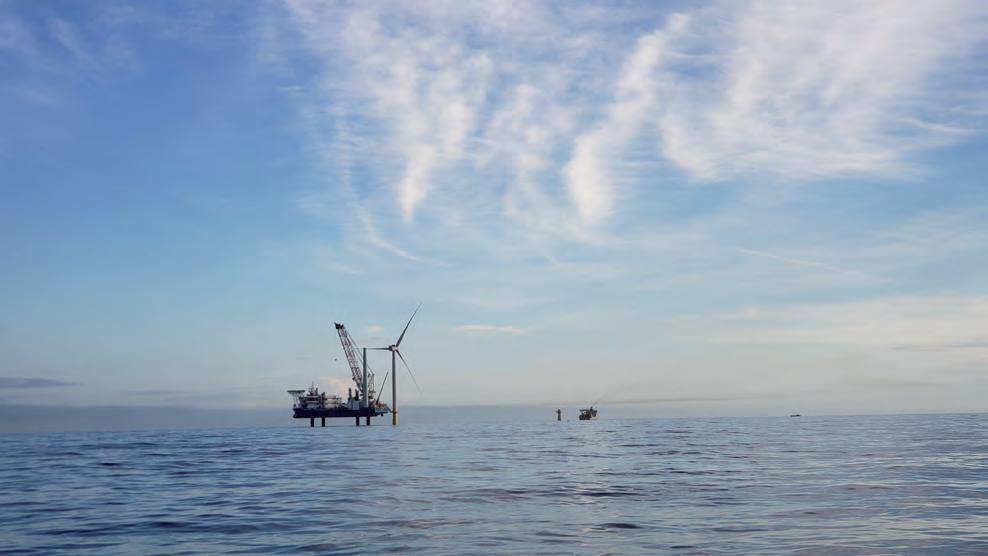
13 minute read
How Early Engagement Can Cut Costs and Enhance Project Outcomes
Meeting Rising Offshore Wind Demand Through Innovative Technologies and Services
How Early Engagement Can Cut Costs and Enhance Project Outcomes
Acteon, a leading provider of services to the offshore wind industry, is growing, along with the rapidly expanding offshore wind market. The company believes it is important to listen and respond to customers and to get in early on projects to deliver benefits such as new survey methods that increase safety and reduce costs.
According to the International Renewable Energy Agency, an almost tenfold increase in installed offshore wind power capacity is needed by 2030 to meet the Paris Climate Agreement goals. Investment in offshore wind may be accelerated if governments back a green recovery following the global Covid-19 crisis. Furthermore, barely a week goes by without a new wind-powered green hydrogen scheme being announced, such as the Shell-led NortH2 wind-to-hydrogen project in the North Sea. The expansion of offshore wind is no longer confined to northern Europe and China, and offshore renewable energy projects are now gathering pace in places such as Taiwan, Japan and off the US East Coast. The levelized cost of offshore wind energy has halved in just five years and some new developments are competitive without subsidies. This has been achieved by applying lessons learned from one project to the next: cumulative
Turbine construction, East Coast US. TerraSond performed UXO clearance surveys of the area.
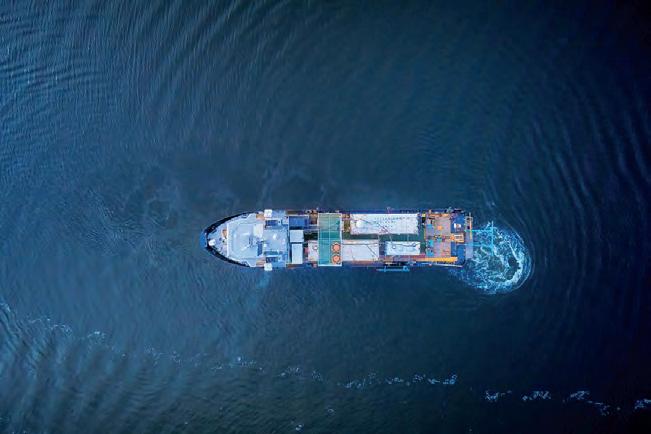
improvements in survey and installation efficiency are delivering significant savings owing to the scale of developments.
DOUBLInG SUrveY SPeeDS
TerraSond’s geophysical work on the US East Coast is a good example of early engagement and the Acteon group’s desire to listen to customers and respond to their needs. TerraSond, a geoservices survey company and part of Acteon, has been involved in nearly all of the East Coast offshore wind developments, including the Mayflower, Atlantic Shores, Coastal Virginia and Kitty Hawk projects. Early and continued participation has helped the company to understand the needs of its customers and the regulatory environment. The TerraSond teams know how to do the work to meet the technical specifications and regulatory and safety requirements and, ultimately, to help customers to design, build and maintain wind farms safely and effectively. Renewables development is driven by the climate emergency, so developers need to demonstrate to their stakeholders that they are actively reducing the carbon footprints of offshore operations while improving safety and environmental performance and driving down costs. In 2018, TerraSond helped to address these needs for Bay State Wind, a joint venture between Ørsted and Eversource, off Massachusetts, through the deployment of the first unmanned surface vessel (USV) to be equipped with a full range of geophysical sensors. The 40-ft USV was remotely operated from and worked in parallel with a standard, manned, 200-ft survey vessel. This effectively doubled the survey capacity and speed, thereby improving safety by halving the time that the 35-person crew spent offshore. Cutting the survey time also helped to reduce the project costs. In addition, the smaller, lighter vessel burned less fuel and posed less collision risk to marine life, including the remaining 400 North Atlantic right whales – one of the world’s most endangered species. Other companies are starting to use smaller USVs but without the full array of sensors necessary for a comprehensive geophysical survey. TerraSond uses these smaller USVs for its charting work for the National Oceanic and Atmosphere Administration. Acteon is further reducing the number of offshore personnel through the development of innovative, automated, sensor launch-andrecovery systems and data compression methodologies that enable real-time data quality control to be brought onshore. Site investigation surveys are part of the early-stage development of an offshore wind farm. Get them wrong and the wind turbine foundations could have structural issues and a suboptimal layout that affect the project throughout its life. Integrating geophysical and geotechnical surveys can help to improve project outcomes. TerraSond previously worked alongside Benthic but, now that both are Acteon operating companies, they respond like one company. Collaborative working helps to avoid laborious data reformatting and reduces the risk of data integrity issues. This enhances efficiency and leads to higher-quality data and, ultimately, a more accurate ground model for de-risked, more cost-effective structure designs. Customers get a single point of contact and contract, which makes their lives easier too. Major contractors may prefer to procure individual services but, if they are willing, Acteon can integrate its services to simplify project interfaces and reduce the back-of-boat footprint. For example, the company offers installation, handling, pile-cleaning, grouting and positioning services, which, when integrated, can lead to the sharing of people and equipment such as generators.
TerraSond Chartered survey vessel conducting COP surveys on the US East Coast.
Survey Sensors installed on the back deck to support Construction Operations Planning surveys.
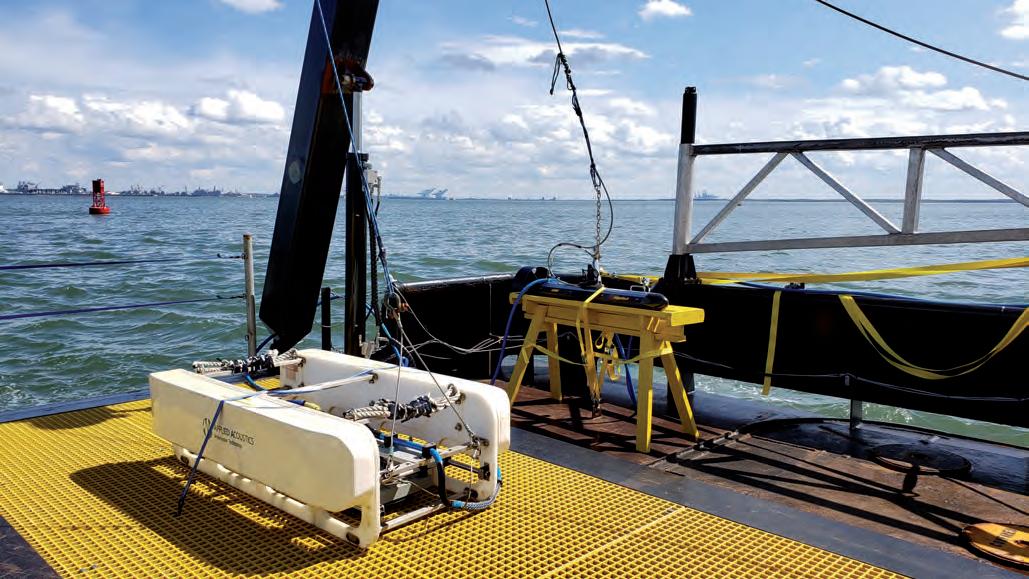
DeSIGnInG OUt MarIne nOISe
The nature of site investigation means that survey teams are among the first people on-site, but Acteon believes that early engagement of the construction supply chain is beneficial too, as it is easier to challenge specifications and designs early on (on paper) for reduced costs and improved performance over the project’s lifetime. Customers have valuable experience, but Acteon brings inch-wide, mile-deep domain knowledge and lessons learned from previous projects that can help customers to transform their project results. Acteon teams know their equipment intimately. For example, the noise generated by piledriving must be kept within strict limits to protect marine life. Acteon company MENCK works closely with major contractors to optimize monopile design, down to the properties of their hammers, and a site’s geotechnical conditions. This helps to engineer out some of the installation noise, which enables more efficient driving and thus reduces installation time for each monopile. The optimized design also uses less steel. Multiply the time and material savings by the large number of monopiles installed for each wind farm, and the figures become significant. MENCK has recently completed piledriving for Van Oord on Vattenfall’s Kriegers Flak offshore wind farm, which will be Denmark’s largest.
neW ventUreS
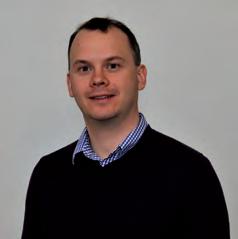
Listening and responding to customers is not only about coming up with technical innovations; it is also about being agile. For example, in Taiwan, Acteon customers need to demonstrate local content development, so, in 2020, the organization established an operational base that it is using to build a local supply chain and develop local talent. Developing local expertise and services enables Acteon to respond more rapidly to customers’ needs and helps to drive down costs by reducing reliance on international support. Acteon is supporting several offshore wind projects from the new base. For instance, two of its operating companies, Pulse Structural Monitoring and Deepwater, are designing and delivering an integrated structural and corrosion-monitoring programme for one of the latest wind farm developments in the region. High-quality corrosion, bending and torsional strain, inclination, displacement and acceleration data from key components of the jacket legs, nodes and wind turbine generator towers are providing information via a web-based system. In 2020, Acteon also formed a partnership with Siemens Gamesa to provide a fully integrated offshore wind turbine operations and maintenance package for Dominion Energy’s Coastal Virginia Offshore Wind pilot project in the USA. In this instance, Acteon companies TerraSond, Seatronics, Deepwater and Clarus are providing subsea asset integrity equipment and services. Coordinating above- and below-water services aims to reduce turbine downtime for planned maintenance activities and thus lower the cost of energy. There are early engagement advantages to asset integrity management too. Designing an asset integrity programme during the pre-development phase, when designs may easily be adapted, can yield efficiencies throughout a project’s operational phase.
a FLOatInG FUtUre
Floating wind will be a major part of the future energy mix, and an estimated $33 billion of contracts will be awarded over the next five years. More than 80% of the total offshore wind energy resource is in waters deeper than 60m, where bottom-fixed installations are not feasible. The wind is stronger and more consistent further offshore. For example, the world’s first commercial floating wind farm, Hywind Scotland, set a new capacity record in 2019 with a median output of more than 59% of peak power; the next-best North Sea wind farm achieved just 48.4%. Floating wind also opens regions where the seabed drops away steeply, such as off Japan and the US West Coast. One of the main advantages of floating wind farms is that the structures can be assembled in port and towed to the site. This reduces the need for expensive installation vessels, cuts the number of offshore personnel and supports local supply chains. The installation of the anchors is also less invasive than driving monopiles or piles for jackets, creates less noise disturbance, and is further from fragile coastal ecosystems and marine users such as fishing and transportation. Floating wind is rapidly decreasing in cost. For example, Equinor expects the cost of its Hywind Tampen floating wind farm in the Norwegian North Sea to be 40% lower than the Hywind Scotland project. Early engagement will be even more critical for floating wind. Acteon company InterMoor has plenty of experience in mooring and anchoring mobile offshore drilling units and other floating oil and gas assets. However, the obvious difference is scale. Whereas a floating production storage and offloading vessel typically has an array of 12 chains and anchors, a large floating wind farm might need such arrays for tens or hundreds of floating structures. The supply chains will need to be brought in early, as mooring has never been attempted at the scale needed to enable deepwater offshore wind. Acteon knows how to do this well for oil and gas assets. Early engagement will help to drive down costs for larger-scale projects. For example, when Acteon began grouting multiple jackets and monopile wind foundations, it modified its equipment to help reduce cycle times and ensure sufficient capacity and robustness to complete large, continuous installation campaigns. The same process needs to happen for floating wind installations; with its extensive mooring equipment inventory, InterMoor is in a prime position to deliver this at the cost customers need. Site investigation in these deeper waters requires geophysical data collection using autonomous underwater vehicles, something TerraSond and others routinely use for oil and gas projects. In addition, Benthic’s Portable Remotely Operated Drill (PROD) seafloor drilling system may be more cost-effective than using drillships in deep water.
enGaGe earLY tO CaPtUre DeeP DOMaIn KnOWLeDGe
The rapid growth of the offshore wind industry, including its expansion into new regions such as the Far East and the US East Coast and into deeper water continues to gather pace. To lower the cost of offshore wind energy further and improve project outcomes, suppliers need to engage early in projects to fully harness their deep domain knowledge, something that Acteon is keen to do.
Ivan Harnett is the renewables market development lead at Acteon with responsibility for building Acteon’s renewables market strategy and engagement with key clients.
Prior to his current role, he founded the Acteon group company Core Grouting Services, which provides specialist grouting services to offshore wind farm construction projects. He has also worked as a management consultant with A.T. Kearney and spent several years designing and building gas plants with Bechtel.
Harnett holds a degree in Chemical Engineering from the Cork Institute of Technology and an MBA from INSEAD.
Biological, Hydrographic and Oceanographic Accomplishments in the Late 19th Century
The Siboga Expedition
The Indonesian archipelago is one of the world’s most beautiful archipelagos. Home to over 17,000 islands, mountains rising to over 5,000 metres, including over 70 historically active volcanoes, fabled spices, and a rich flora and fauna, Indonesia has beckoned fortune-seekers and naturalists for centuries. The shores of its far-flung islands are bathed by 2 oceans and at least 11 separate seas, making it a challenging area for hydrographers. In the late 19th century, Indonesia was administered by the Dutch and known as the Dutch East Indies.
The terrestrial flora and fauna of the area was fairly well known because of the work of the English naturalist Alfred Russel Wallace between 1862 and 1869. Wallace, also known for being credited by Darwin as having independently formulated the theory of evolution, discovered that species west of a dividing line between Borneo and Sulawesi and between the Philippines and Halmahera were more closely related to Asian species and those east of the line were more closely related to Australian species. This line became known as the Wallace Line and helped to provide at least partial inspiration for a Dutch expedition 30 years later.
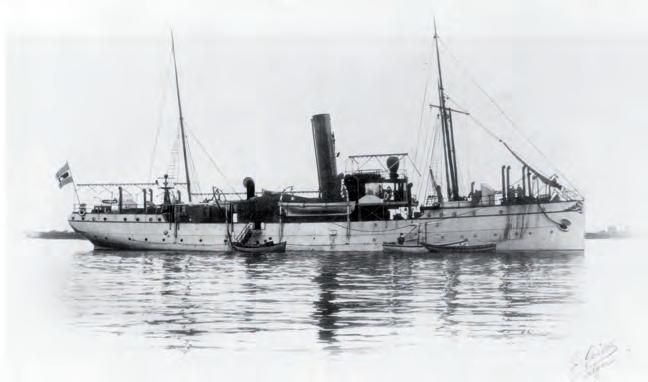
A project for the study of the marine fauna, particularly that of the deep-sea basins of the Dutch East Indies, was suggested by the Society for the Advancement of Scientific Research in the Netherlands’ Colonies in 1896. Dr Max Weber, a noted Dutch zoologist of GermanDutch descent, volunteered to lead this expedition. Weber was primarily known for his work as a mammalogist but in 1881 had been the naturalist on the voyage of the Willem Barentsz, a Dutch expedition to the Arctic Ocean. He had also married Anna Antoinette van Bosse, a wealthy widow who was unique in that she was an outstanding marine biologist and expert in marine algae. Together they had spent three summers in northern Norway; he studying the anatomy of whales, and Anna studying calcareous algae. In 1888, they went to the Dutch East Indies to study the distribution of animal life throughout the archipelago. They were therefore exceedingly well qualified to lead a scientific expedition.
First Woman scientist
Serendipitously, the government of the Dutch East Indies was constructing a small gunboat that was modified for dredging and sounding operations. This vessel was the Siboga, a twin-screw vessel of slightly over 50 metres in length. Launched in 1898 in Amsterdam, it sailed to the East Indies, and on 7 March 1899, began its year-long exploration of the Indonesian seas. The ship’s complement included 10 Dutch naval officers, 45 native crew, 6 scientists including Max and Anna Weber, and 2 personal servants. The inclusion of Anna Weber in this expedition marks a milestone as she was the first woman scientist to take part in a major oceanographic expedition.
From a biological viewpoint, the Siboga expedition was a great success. Many new species were discovered and Weber showed that the Wallace Line was more of a transitional zone than a sharp demarcation. He determined a line that marked the 50/50 distribution of Asiatic versus Australian species which today is known as the Weber Line. Over 60 volumes were published detailing the results of this expedition, the most recent being published in 1986. As early as 1922, the importance of this work was recognized in the journal Nature:
“The stately series of reports on this expedition, which have been appearing under his (Weber’s) editorship since 1902, form a contribution to the science of the sea scarcely surpassed in importance save by those of the Challenger expedition. Dealing with only a restricted area of the ocean, but paying far more attention to the fauna and flora of the shallower waters than the naturalists of the Challenger were able to do, it is not too much to say that the Siboga expedition has given a new aspect to many problems of the distribution of marine animals in tropical seas.” Nature, 22 December 1922.
The gunboat Siboga, used for the Siboga Expedition. Read the full article on hydro-international.com!






